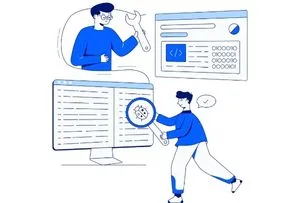At Experion Technologies, we deliver robust software product testing solutions that bring together strategy, automation, and innovation to ensure every product is reliable, secure, and market-ready.
In today’s highly competitive business landscape, testing is no longer seen as the final checkpoint in the software development lifecycle. Instead, it has become a critical enabler of business success. A well-executed software testing process ensures superior user experiences, reduces the risk of costly post-release failures, and builds long-term customer trust. By investing in end-to-end software testing, organizations can detect defects early, validate performance, and align product outcomes with customer expectations.
Browse the Sections:
- What is Software Product Testing?
- Types of Software Testing
- The Importance of Software Testing in Product Development
- Common Challenges in Software Product Testing
- Building a Software Product Testing Strategy
- Achieving Quality with End to End Software Testing
- Trends and Innovations in Software Product Testing
- Common Pitfalls to Avoid in Software Product Testing
- Significance of Software Testing Services
- How Experion Can Support in Software Product Testing?
- Conclusion
- Key Takeaways
What is Software Product Testing?

Software product testing is the process of evaluating and validating a software application or product to ensure it meets defined business requirements, technical specifications, and quality standards. The ultimate objective of product testing is to confirm that the software behaves as expected under different conditions, delivers consistent performance, and provides a seamless user experience.
The discipline is not limited to identifying defects. It also involves proactively measuring efficiency, scalability, and security, ensuring that businesses can deliver solutions that are both innovative and dependable. This is where a structured software product testing strategy becomes essential.
The software testing lifecycle (STLC) provides a systematic framework to achieve these objectives. It typically involves several phases:
- Requirement Analysis: Identifying business goals and technical specifications to shape the testing scope.
- Test Planning: Designing test strategies, estimating resources, and scheduling testing activities.
- Test Case Design: Developing detailed test cases and test scripts that cover functional and non-functional aspects.
- Test Environment Setup: Preparing infrastructure and data environments to simulate real-world conditions.
- Test Execution: Running test cases, recording outcomes, and validating expected results.
- Defect Tracking and Reporting: Logging defects, analyzing their root causes, and prioritizing fixes.
- Closure Activities: Reviewing deliverables, measuring coverage, and preparing reports to validate test effectiveness.
Following the STLC ensures that organizations achieve consistent and thorough software testing results, reducing risks and supporting faster, more reliable product launches.
Quality isn’t an afterthought, it’s the foundation.
Let Experion test your way to success.
Start your quality journey with us
Types of Software Testing
There are several types of software testing services available to ensure that every aspect of a product is validated. Each plays a unique role in creating high-quality outcomes.
- Manual Testing: This approach requires testers to perform test cases manually, without automation. It is particularly useful in exploratory scenarios, usability validation, or situations where human intuition is critical. Although slower than automation, it is invaluable for detecting user experience issues.
- Functional Testing: This form of testing verifies that all software features work according to defined specifications. By simulating real-world scenarios, functional testing ensures that core product functionalities deliver the intended outcomes without defects.
- Non-functional Testing: Beyond functionality, non-functional testing evaluates aspects such as performance, scalability, reliability, and usability. It ensures that the product performs well under stress and meets expectations for speed, responsiveness, and stability.
- Regression Testing: Whenever updates or new features are introduced, regression testing checks that existing functionalities continue to work as expected. It minimizes the risk of unintended side effects from code changes and supports continuous delivery.
- Performance Testing: This involves testing the product under varying levels of load and stress to measure responsiveness, stability, and scalability. Performance testing helps prevent bottlenecks and ensures a consistent experience across user volumes.
- Exploratory Testing: Exploratory testing relies on the creativity and domain knowledge of testers who design and execute tests on the fly. It is particularly effective in identifying unexpected defects that structured test cases might miss.
- Usability Testing: Usability testing evaluates how user-friendly and intuitive the product is. By observing real users interacting with the software, testers can uncover issues that hinder user adoption and satisfaction.
- Security Testing: Security testing is designed to uncover vulnerabilities, ensure data protection, and validate that the product meets regulatory compliance requirements. It is especially important for industries like finance, healthcare, and e-commerce where sensitive data is at stake.
Together, these testing types form the foundation of a comprehensive software product testing strategy. By combining manual testing, automated software testing services, and specialized approaches, organizations can achieve maximum coverage and deliver products that meet the highest quality standards.
The Importance of Software Testing in Product Development
 Software testing is one of the most crucial aspects of modern product development, ensuring that applications are not only functional but also reliable, secure, and scalable. Without a carefully planned software product testing strategy, businesses face the risk of delivering products that are defective, unstable, or unable to meet customer expectations. The consequences of poor testing are significant, ranging from revenue loss and reputational damage to reduced user adoption.
Software testing is one of the most crucial aspects of modern product development, ensuring that applications are not only functional but also reliable, secure, and scalable. Without a carefully planned software product testing strategy, businesses face the risk of delivering products that are defective, unstable, or unable to meet customer expectations. The consequences of poor testing are significant, ranging from revenue loss and reputational damage to reduced user adoption.
- Quality Assurance: Rigorous software product testing provides confidence that the product meets both functional and non-functional requirements. This involves validating features against business specifications while also ensuring that performance, usability, and security standards are consistently maintained.
- Cost Implications: Addressing defects after a product has been released is considerably more expensive than identifying them early in the development process. Investing in strong software testing services, including automated software testing services, reduces long-term costs by catching defects during development, where fixes are simpler and less disruptive.
- Customer Satisfaction: A seamless, bug-free experience is vital for customer trust and loyalty. When businesses invest in testing software products thoroughly, they ensure faster adoption rates and improved retention. Products that are stable and intuitive foster confidence, ultimately enhancing customer satisfaction and strengthening brand reputation.
In essence, software product testing is not a cost center but a value enabler. It allows businesses to accelerate time-to-market, reduce risks, and deliver products that are built for long-term success.
Common Challenges in Software Product Testing
Despite its importance, organizations face several challenges when implementing effective software product testing processes. These challenges highlight the need for a strategic, adaptable approach.
- Managing Complex Environments and Integrations: Modern software products are built to integrate with multiple systems, APIs, and third-party services. Testing across these complex environments is resource-intensive and requires specialized expertise. Without proper planning, gaps in integration testing can lead to failures in production.
- Keeping Pace with Frequent Release Cycles in Agile/DevOps: Agile and DevOps methodologies demand continuous delivery and rapid iteration. Testing must keep pace with these accelerated cycles, which often strains traditional approaches. Incorporating continuous testing and automation is essential to meet deadlines without compromising quality.
- Balancing Manual and Automated Software Testing Services: While manual testing is critical for areas such as exploratory and usability testing, automation is indispensable for regression, performance, and large-scale validation. Striking the right balance between manual effort and automated software testing services remains a challenge, particularly when budgets and timelines are tight.
- Ensuring Complete Test Coverage While Meeting Tight Deadlines: Comprehensive test coverage is necessary to uncover hidden defects, yet achieving it under strict time constraints can be difficult. Teams often face trade-offs between speed and thoroughness, which can result in incomplete testing and overlooked issues.
These challenges make it clear that organizations require not only skilled testing teams but also a well-defined software product testing strategy that leverages tools, automation, and best practices to ensure consistent outcomes.
Don’t just build software, build trust with every release.
Explore our testing solutions
Building a Software Product Testing Strategy
 A well-structured software product testing strategy is essential for ensuring consistency, maximizing test coverage, and aligning testing efforts with broader business objectives. Without a defined approach, testing software products can become fragmented, leading to inefficiencies and missed defects. By following a systematic framework, organizations can balance speed, cost, and quality to deliver reliable outcomes.
A well-structured software product testing strategy is essential for ensuring consistency, maximizing test coverage, and aligning testing efforts with broader business objectives. Without a defined approach, testing software products can become fragmented, leading to inefficiencies and missed defects. By following a systematic framework, organizations can balance speed, cost, and quality to deliver reliable outcomes.
Key steps in building an effective software product testing strategy include:
- Requirement Analysis: The foundation of any testing effort begins with a clear understanding of both business needs and technical requirements. This step ensures that test cases are designed with the end user in mind, covering functional expectations as well as performance, usability, and security needs.
- Test Planning and Environment Setup: Once requirements are defined, teams move into detailed test planning. This includes designing test cases, preparing test data, and creating the necessary environments. A well-prepared test environment mirrors real-world conditions, making validation more accurate and reliable.
- Automation vs. Manual Testing: No single method fits all testing scenarios. Manual testing is valuable for usability, exploratory checks, and areas where human judgment is essential. At the same time, automated software testing services play a critical role in regression, load testing, and repetitive tasks. Striking the right balance ensures efficiency while maintaining depth and accuracy.
- Continuous Testing in Agile/DevOps: In today’s fast-paced development environments, testing must be embedded into the continuous integration and continuous delivery (CI/CD) pipeline. Continuous testing ensures rapid feedback loops, enabling quicker defect resolution and supporting faster, more reliable product releases.
- Best Practices for Strategy Alignment: An effective software product testing strategy is not just about tools and processes but also about aligning with business goals. This means maintaining traceability across requirements, test cases, and results while ensuring transparency in reporting and accountability at every stage.
At Experion Technologies, we design customized testing strategies that combine domain expertise with automated software testing services, ensuring that every client achieves maximum value from their investment in quality assurance.
Achieving Quality with End-to-End Software Testing
Delivering a seamless user experience requires more than isolated checks. End-to-end software testing validates the entire user journey, ensuring that every interaction, workflow, and integration performs as intended. By simulating real-world scenarios, it verifies that different components of a system work together flawlessly, eliminating risks before the product reaches users.
Coverage areas in end-to-end testing include:
- User Journey Validation: From login and navigation to checkout or data submission, every user flow is tested thoroughly to ensure that all features function correctly and consistently. This approach captures gaps that might only become evident when multiple features interact.
- Integrations and APIs: Modern products rarely operate in isolation. They rely on integrations with third-party services, APIs, and internal systems. End-to-end testing ensures seamless data exchange and consistent performance across these connections, reducing the risk of integration failures.
- Workflows and Systems: Business processes often span multiple modules and systems. End-to-end testing verifies that these workflows execute as expected, from start to finish, without interruptions or errors.
Tools and Frameworks Supporting End-to-End Testing
Organizations can rely on a wide range of tools to achieve reliable end-to-end software testing. Popular frameworks such as Selenium, Cypress, Appium, and JUnit support automation across functional and non-functional tests. These tools not only accelerate testing cycles but also provide repeatable, scalable validation that aligns with modern development practices.
By validating the complete ecosystem, end-to-end testing ensures a cohesive product experience that strengthens customer trust. It minimizes the risk of defects slipping into production and provides organizations with the confidence that their product will perform seamlessly across real-world environments.
Launch faster, safer, and smarter with Experion’s software testing services.
Request a consultation
Trends and Innovations in Software Product Testing

The field of software product testing is undergoing rapid transformation as organizations look for ways to improve speed, accuracy, and cost efficiency in their quality assurance processes. Traditional testing approaches are giving way to advanced methods and tools that support modern development practices such as Agile and DevOps. These innovations not only reduce time-to-market but also improve reliability across complex systems.
- AI-Driven Test Automation: Artificial intelligence is making test automation smarter by enabling intelligent test case creation, predictive defect identification, and adaptive testing. This reduces human effort, enhances accuracy, and allows businesses to focus resources on higher-value testing activities.
- Ethical and Fairness Testing: As AI and machine learning become integral to software products, testing must also ensure fairness, transparency, and absence of bias. Ethical testing frameworks help validate that AI-driven systems are free from discrimination and comply with responsible AI standards.
- Low Code/No Code Testing: Low code and no code platforms are democratizing software testing services by enabling non-technical users to design and execute automated tests. This accelerates adoption of automated software testing services and reduces dependency on specialized coding skills.
- Shift-Left Testing: By moving testing earlier in the development lifecycle, shift-left testing helps teams detect defects during the design and coding phases. This reduces rework, shortens release cycles, and lowers overall costs associated with testing software products.
- Cloud-Based Test Environments: Cloud platforms are enabling scalable, on-demand, and cost-efficient testing environments. Teams can replicate real-world scenarios across devices, browsers, and operating systems without maintaining expensive in-house infrastructure.
- Continuous Integration/Continuous Testing Pipelines: CI/CT pipelines integrate end-to-end software testing into the development process, ensuring that every code change is automatically validated. This continuous approach provides instant feedback, supports faster releases, and aligns perfectly with Agile and DevOps practices.
Together, these innovations are redefining the future of software product testing strategy, enabling enterprises to test faster, smarter, and at greater scale.
Common Pitfalls to Avoid in Software Product Testing
While investing in software testing services is critical for quality, many organizations still encounter pitfalls that reduce the effectiveness of their efforts. Being aware of these challenges can help businesses strengthen their approach and improve results.
- Over-Reliance on Manual Testing: Manual testing is essential for usability and exploratory testing, but depending on it exclusively can slow down release cycles and reduce coverage. Incorporating automated software testing services is necessary to achieve efficiency and scalability.
- Incomplete Test Coverage Leading to Hidden Defects: Skipping certain scenarios or failing to account for edge cases often results in undetected bugs that surface in production. A comprehensive software product testing strategy ensures that coverage spans functional, non-functional, and integration testing.
- Poor Documentation Affecting Reproducibility: Inadequate documentation makes it difficult to reproduce defects and hinders collaboration between development and QA teams. Clear and traceable documentation is vital for accurate defect resolution and long-term maintainability.
- Ignoring Non-Functional Requirements Such as Performance and Security: Many organizations focus primarily on functionality and overlook performance, scalability, and security. These aspects are just as critical as core features, particularly in industries like healthcare, finance, and retail where compliance and reliability are paramount.
Avoiding these pitfalls ensures that businesses maximize the value of their investment in software product testing while delivering products that are secure, reliable, and customer-ready.
Significance of Software Testing Services
 For many organizations, managing in-house testing teams can be resource-intensive and difficult to scale. This is why an increasing number of businesses rely on external software testing services to ensure quality while optimizing costs and delivery timelines. By partnering with experienced providers, enterprises gain access to proven methodologies, advanced tools, and specialized expertise that might not be available internally.
For many organizations, managing in-house testing teams can be resource-intensive and difficult to scale. This is why an increasing number of businesses rely on external software testing services to ensure quality while optimizing costs and delivery timelines. By partnering with experienced providers, enterprises gain access to proven methodologies, advanced tools, and specialized expertise that might not be available internally.
- Why Outsource? Outsourcing allows organizations to scale testing efforts quickly while accessing dedicated professionals with deep technical expertise. Businesses benefit from cost optimization, faster time-to-market, and the ability to focus their internal teams on product development rather than testing overhead.
- Core Services Offered: Leading testing providers offer a comprehensive range of services such as QA consulting, automated software testing services, performance testing, security testing, and usability testing. These services ensure that both functional and non-functional aspects of the software are thoroughly validated.
- Benefits: By leveraging external software product testing services, businesses achieve faster releases through automation, improved quality through broader test coverage, and scalability to handle peak testing needs. They also reduce risks associated with compliance failures, undetected defects, or unstable releases.
- Choosing a Partner: Selecting the right provider is critical. Organizations should evaluate domain knowledge, proven testing frameworks, and the ability to align with Agile and DevOps practices. Equally important is the provider’s expertise in both manual and automated testing, as well as their ability to deliver an end-to-end software testing strategy that supports long-term business goals.
When done strategically, outsourcing testing is not just a cost-saving measure but a way to enhance quality, accelerate product launches, and strengthen overall business competitiveness.
How Experion Can Support in Software Product Testing?
 At Experion Technologies, we bring together deep engineering expertise, domain knowledge, and modern testing frameworks to deliver high-quality end-to-end software testing for global clients. Our approach integrates manual testing, automation, and continuous testing within Agile and DevOps environments. This ensures that our clients benefit from shorter release cycles, reduced defects, and products that are ready for market from day one.
At Experion Technologies, we bring together deep engineering expertise, domain knowledge, and modern testing frameworks to deliver high-quality end-to-end software testing for global clients. Our approach integrates manual testing, automation, and continuous testing within Agile and DevOps environments. This ensures that our clients benefit from shorter release cycles, reduced defects, and products that are ready for market from day one.
We tailor each software product testing strategy to client goals, leveraging automated software testing services alongside exploratory and functional testing. By combining advanced frameworks with industry best practices, Experion helps businesses achieve both quality assurance and speed-to-market.
Real-World Examples
- Healthcare: Experion supported a global healthcare provider in achieving compliance with HIPAA regulations through rigorous security and usability testing. The result was a system that safeguarded sensitive patient data while offering an intuitive experience for users.
- Fintech: For a leading fintech client, we designed a scalable automated software testing framework that reduced regression testing time by 60 percent. This allowed the client to accelerate their release cycles without compromising quality or compliance.
- Retail: A global retail platform partnered with Experion to build a continuous testing pipeline integrated with their Agile workflows. This solution significantly improved release velocity and reduced post-release defects, enhancing customer satisfaction and operational efficiency.
Through these engagements, Experion has demonstrated the value of testing software products with a holistic, business-focused approach. Whether through performance optimization, compliance validation, or accelerated delivery, our solutions are designed to help clients stay competitive in dynamic markets.
Conclusion
A strong software product testing strategy forms the backbone of successful software development. It is not merely a checkpoint at the end of the lifecycle but an ongoing process that ensures quality, performance, compliance, and customer satisfaction. From reducing risks of defects to improving speed-to-market, testing remains indispensable in building products that inspire trust and deliver consistent value.
By integrating end-to-end software testing, adopting innovative tools, and leveraging advanced practices such as automation, AI, and continuous testing, organizations can enhance the efficiency and accuracy of their quality assurance processes. At the same time, partnering with experienced software testing service providers allows businesses to access specialized expertise, scale quickly, and maintain focus on innovation.
Looking ahead, companies that invest in software testing services will not only future-proof their products but also strengthen their competitive advantage in a digital-first economy.
Key Takeaways
- Software product testing ensures quality, reliability, performance, and security across the lifecycle.
- An effective software product testing strategy aligns testing activities with business goals and user expectations.
- End-to-end testing validates the complete product ecosystem, covering user journeys, integrations, APIs, and workflows.
- Innovations such as AI-driven test automation, low-code and no-code testing, and shift-left testing are transforming the industry.
- Outsourcing software testing services provides scalability, cost efficiency, and access to specialized expertise.
- Balancing manual testing with automated software testing services ensures both depth and efficiency in validation.
- Cloud-based test environments and CI/CT pipelines accelerate releases while maintaining consistent quality.
- Experion empowers clients with customized, industry-specific software product testing solutions that support faster launches, improved compliance, and customer trust.
At Experion Technologies, we go beyond testing software products, we help businesses accelerate innovation with reliable, secure, and scalable software product testing services. Connect with us today to build products that customers trust.

